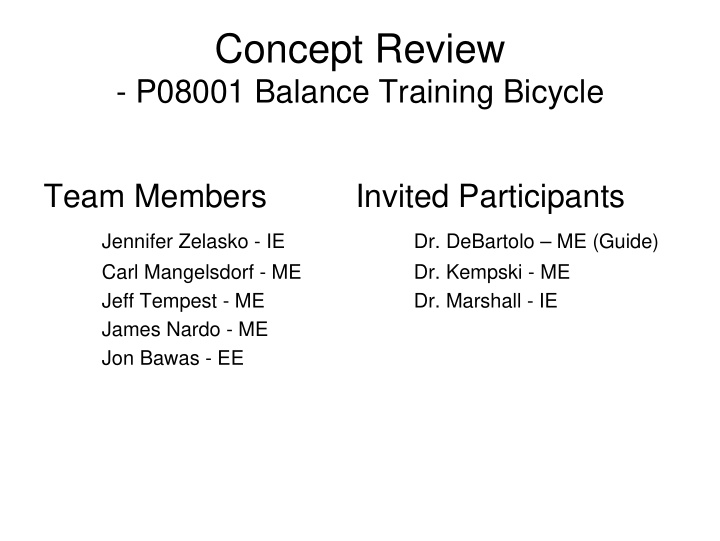



Concept Review - P08001 Balance Training Bicycle Team Members Invited Participants Jennifer Zelasko - IE Dr. DeBartolo – ME (Guide) Carl Mangelsdorf - ME Dr. Kempski - ME Jeff Tempest - ME Dr. Marshall - IE James Nardo - ME Jon Bawas - EE
Meeting: Senior Design Concept Review - Balance Training Bicycle Time: Thursday (January 24, 2008) from 4pm to 6pm Location: Room 4435 - Building 9 Meeting Objective: Analyze and validate the functionality and robustness of the current concept. Also, ensure customer needs and engineering specifications are met.
Background Information • Intermediate step between a stationary and traditional bicycle. • Balance training for recovering physical therapy patients. Free care provided by the Nazareth College PT Clinic. – stroke victims – neurological problems – weak left/right side of body • A physical therapist will be spotting the patient riding the Balance Training Bicycle at all times. • Safety of both the patient and the physical therapist is a priority in the design.
Agenda 4pm – 5pm Overview of Design Process •Customer Needs and Related Engineering Metrics [5 minutes] •Engineering Specifications [10 minutes] Mechanical Design Concepts •Discussion of Well Established Concepts [10 minutes] • Discussion of Tilt Resist Concepts Discussion of Tilt Resist Concepts [35 minutes] [35 minutes] • 5pm – 5:30pm Safety Design Concepts •Preliminary Hazard Analysis [15 minutes] - Concepts to prevent foreseeable hazards Feedback System Concept [10 minutes] •Audio / Visual
QFD Matrix
Specifications
Overall Concept Telescoping Swiveling Handlebars w/ Handlebars w/ Pin-lock Pivoting Arm w/ Pin-lock Locked Positions Telescoping Seat Height w/ Pin-lock Tilt Resistance - Adjustable Spring Pillow Block Ball Assembly Bearing To Allow Lateral Tilt (X2) Wheels For Pedal With Built In Pin-lock control Portability Resistance Knob for upright (Purchase) “Locked Position”
Breakdown of Individual Concepts
Pivoting Arm w/ Locked Positions • Incremental-Angle Hinge • Push Button Adjustment • Ergonomic Design – Adjustable to different patient sizes • Pivot arm with gear teeth and wing nut compression
Swiveling Handlebars w/ Pin-lock •Ball joint swivel bearing
Telescoping Seat Height and Handlebars w/ Pin-lock •Spring Loaded Button on Pin •Spring Plunger Pin (not removable) (removable) •Mount pin on outside cylinder •Inside cylinder has series of holes to position seat height •Ergonomic Design – adjustable to different patient sizes
Pin-lock control for upright “Locked Position” • Located at rear of bike where PT stands to spot patient • Spring loaded • Pull up and turn 90 degrees to keep nose pin up in un-locked position
Pillow Block Ball Bearing To Allow Lateral Tilt (X2) •Rotating axis •Safety •Low Cross Member – Easy On / Off
Pedal With Built-In Resistance Knob •Adjustable resistance knob •Safety •No chains / wheels -Low cross member
Wheels For Portability • “Wheel Barrow” design • Ergonomic Design – Easy to roll – Light lifting
Tilt Resistance -Adjustable Spring Assembly • Non-linear spring inside of cylinder • Adjustable piston used to compress spring, varying tilt levels
Tilt Resistance Mounting bolt threads into worm w/ double nuts and - CONCEPT 1 washers to allow rotation Spring compression is adjusted by spinning outer case Viewable piston height allow PT to select level of tilt and also provides upper piston movement Worm slides in and out of bottom piston with fairly tight tolerance to avoid binding
Tilt Resistance - CONCEPT 2 Same Concept – Spring compression is adjusted with worm gear Piston Fixed to worm gear
Tilt Resistance - CONCEPT 3 (Cable and Pulleys) Side View Front View •Spring compression is adjusted with Winch Top •Winch remote control to rear of bike View •Safety - Cable / Pulleys / Winch enclosed inside of guard cover
? Tilt Resistance - CONCEPT 4 - Bump Stops Top plate (Door Handle)
Safety Concepts • Minimized moving parts • Low cross member – Easy on/off • Adjustable seat height • Adjustable handlebar length and tilt degree • “Wheel Barrow” portability
Safety Concepts Foot Straps Wrist Straps Wide Seat Safety Guards/Covers over moving parts and pinch points “Cruiser” style handlebars •relaxed wrists •good riding posture
Feedback Subsystem • Sensor – Inclinometer – Based on accelerometer technology – Outputs analog voltage • Ex: 44.4mV / degree – Voltages will be used to drive both audio and visual display to patient and PT • Current Issue: Need to determine appropriate tilt ranges for balance and tip-over warnings • Resolution: use sensor to test on PT patients to find average tilt ranges to be “fine-tuned” in final product
Feedback Subsystem • Audio / Visual Display Concept – Visual Feedback • LED Bank – indicating direction and level of tilt • Color Code – Green – normal tilt range – Yellow – region to correct balance – Red – Tip-over condition imminent – Audio Feedback • Speaker provides audio feedback – Adjustable volume – “Beeps” occur at yellow and red warning levels – Volume and pitch remain constant, but as tilt level increases, the intervals at which the beeping occurs will increase
Recommend
More recommend